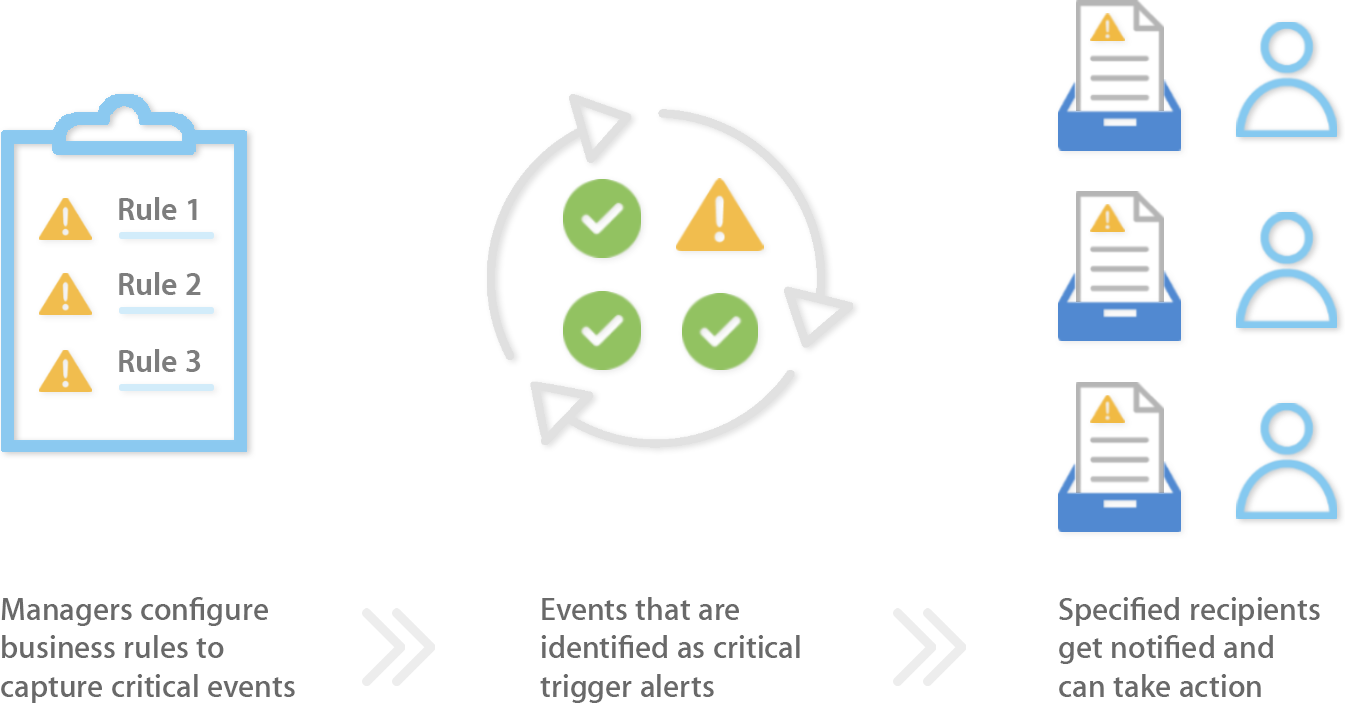Enabling Alerts for Critical Events
Anastasiya Dashuk (Unlicensed)
Chellie Esters
Viktoryia Halukhina (Deactivated)
To manage your facilities more efficiently and capture the most impactful issues that need to be addressed, you can configure business rules that — if met — trigger Critical Alert emails. You may want to be aware of situations that are beyond normal and require prompt action, such as the only oven in a restaurant kitchen being out of order for too long or a security system that broke down twice in one week.
You may create a matrix of business rules that send email notifications to the desired people in case of work order-related events that you consider critical. This allows you to escalate issues faster, without having to dispatch a special request to responsible employees.

Should you want to enable Critical Alerts, contact your CSM, and work with them to configure your matrix of business rules.
Below are a few examples of events for which you may set up Critical Alerts:
- Work orders belonging to a specific trade that stay in the Open status for too long
- Emergency service requests created for equipment that is critical for the operation of your business
- High number of work orders submitted for a particular asset within the specified time period, which may mean the equipment needs replacement
- Overdue service requests that are assigned the highest priority
- A host of work orders sent to a specific provider that are incomplete or waiting for parts for an unreasonably long time
Configuring Business Rules That Trigger Critical Alerts
Business rules for dispatching alerts are highly customizable. When creating a matrix of rules for your company with your CSM, you can configure the following for each rule:
- Email notification parameters:
- Custom email subject and alert message. You may add an attachment to the email if needed.
- Email recipients — employees, providers, or any other people you want to notify. You can include individuals listed in particular Location Note Headers (LNHs).
- Time period relative to the current date for which the rule conditions are checked
- Frequency of sending alerts (no more than once an hour)
- Maximum number of alerts for a triggered condition to be dispatched
- Time period after which alerts for a triggered condition expire
- Date when you may want to disable the rule
- Requirement for a provider to acknowledge an alert. You can add a custom message for a provider to show on the acknowledgment form.
- Rule conditions that — if met — trigger alerts:
Work order properties
Click here to expand a full list of parameters.- Status (Open and/or In Progress) and extended status
- Trade
- Category
- Priority
- Scheduled date
- Assigned provider
- Asset
- Asset type
- Label
- Weather type
- Caller
- Problem code
- Problem type
- Area
Locations to apply the rule to
Click here to view location parameters.- Location note headers (LNHs)
- Location ID
- Store ID
- Location name
- Address
- Opening and closing date
Areas where the rule should be valid
Click here for details.- Regions
- Districts
- Cities
- States
- Countries
Customizable filters (not limited to the listed below):
- Minimum number of work orders submitted for a single location
- Time period during which the service request has been in a specific status
- NTE less than or greater than the amount you specify
The above information is provided only for your reference. Contact your CSM to set up your business rules that trigger Critical Alerts.
As soon as your CSM completes setting up Critical Alerts for your company, those people whose emails you specify will start getting real-time notifications about events that you think require immediate escalation.
Configuring Rules That Trigger the Provider Auto-reassignment on Work Orders
To have better control over the dispatched work orders, subscribers can set up auto-reassignment rules. These are additional rules for Critical Alerts that, if met, will trigger automatic reassignment of a work order to another provider.
Contact your ServiceChannel representative to configure additional rules within the Critical Alerts functionality.
- Set one or both rules to trigger a work order reassignment:
- A work order is in the Open status with no confirmation from a provider.
- A work order is in any Open or In Progress status, and there are no more actions taken by a provider within a certain period of time.
For both rules, you need to specify the number of hours a work order can be in the current state before being reassigned.
- If needed, indicate the work order categories that will not be subject to reassignment.
- Specify the order in which providers will be reassigned:
- Sequential. You do not need to specify any rankings because it follows the provider ranks you have already set for the specified location and trade.
- Custom. You can set another ranking unlike the sequential. The maximum is 100 providers.
- When the list of providers, either sequential or custom, reaches its end, you can choose to receive a notification email prompting you to reassign a work order to another provider manually.
The rules set will affect previously created work orders if all conditions are met.
